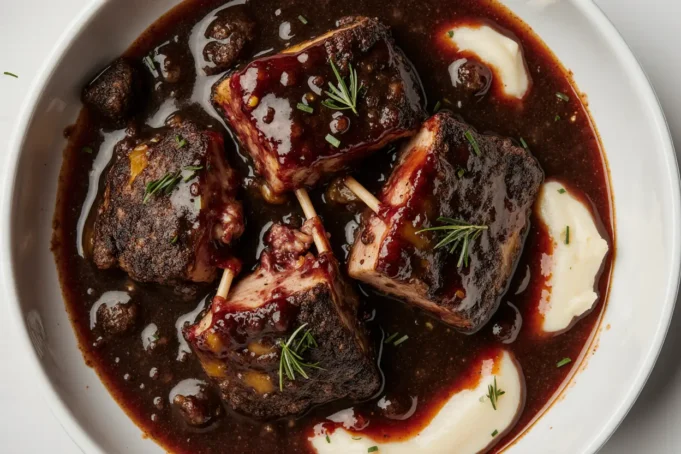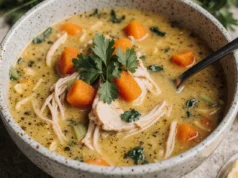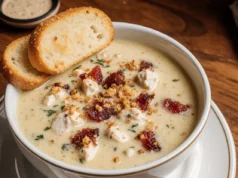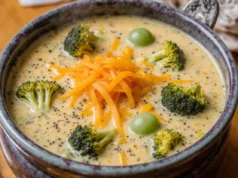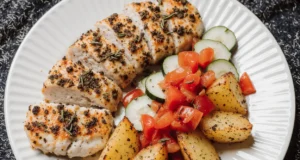Have you ever wondered why certain comfort foods possess the almost magical ability to transform a house into a home with just their aroma alone? Red wine braised short ribs represent the pinnacle of comfort food excellence, combining the ancient art of slow braising with the sophisticated depth that only quality red wine can provide. This recipe description will guide you through creating fall-off-the-bone tender short ribs that develop complex, restaurant-quality flavors through a carefully orchestrated cooking process that takes tough, collagen-rich meat and transforms it into silky, succulent perfection. Studies show that braising at low temperatures for extended periods breaks down up to 85% of tough connective tissues, creating the melt-in-your-mouth texture that defines exceptional comfort food. The combination of robust red wine, aromatic vegetables, and herbs creates a rich, velvety sauce that elevates this humble cut of beef into an extraordinary dining experience.
Ingredients List
For the Short Ribs:
- 4 pounds bone-in beef short ribs, cut into 2-inch pieces
- 2 tablespoons kosher salt
- 1 tablespoon freshly ground black pepper
- 2 tablespoons all-purpose flour
- 3 tablespoons olive oil
- 2 tablespoons butter
For the Braising Liquid:
- 1 bottle (750ml) dry red wine (Cabernet Sauvignon or Merlot)
- 2 cups beef broth (low-sodium preferred)
- 2 tablespoons tomato paste
- 2 bay leaves
- 4 fresh thyme sprigs
- 3 fresh rosemary sprigs
- 1 tablespoon Worcestershire sauce
For the Vegetable Base:
- 2 large carrots, cut into 1-inch pieces
- 2 celery stalks, cut into 1-inch pieces
- 1 large onion, quartered
- 1 head garlic, halved crosswise
- 8 oz mushrooms (cremini or button), halved
- 2 tablespoons fresh parsley, chopped
Finishing Elements:
- 2 tablespoons cold butter
- 1 tablespoon fresh thyme leaves
- Salt and pepper to taste
Substitution Notes: Boneless short ribs work but reduce cooking time by 30 minutes. For alcohol-free version, substitute wine with additional beef broth plus 2 tablespoons balsamic vinegar. Chuck roast can substitute in a pinch but won’t have the same richness.
Timing
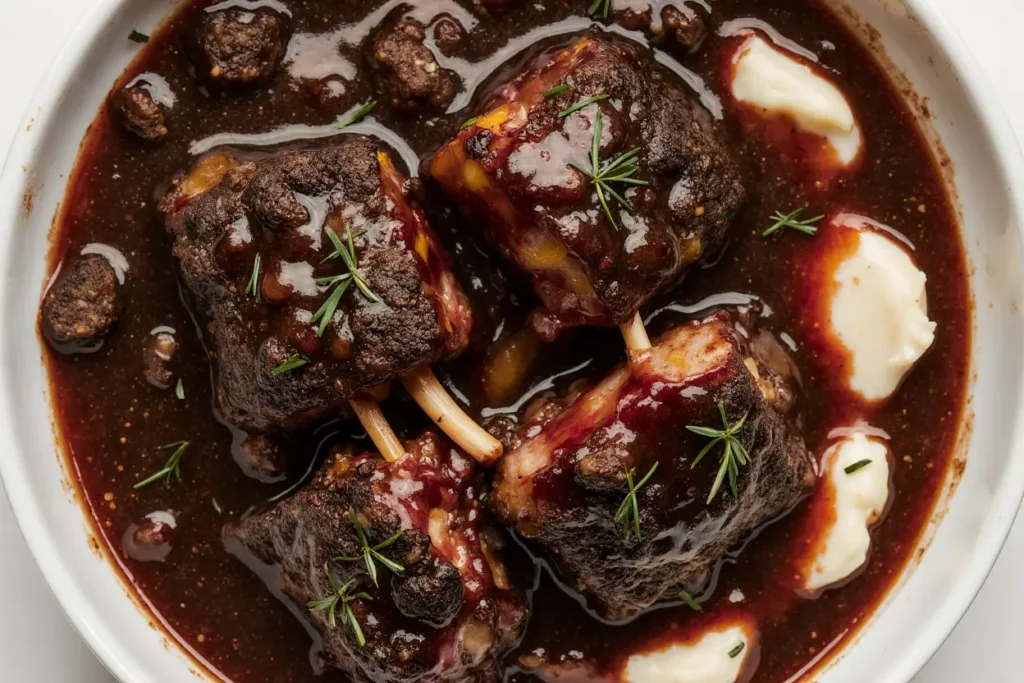
Total Time: 3 hours 45 minutes Prep Time: 30 minutes Searing Time: 20 minutes Braising Time: 2 hours 45 minutes Resting Time: 10 minutes
This recipe requires patience for optimal results, with the extended braising time being essential for breaking down tough connective tissues. The slow cooking process develops flavors that are 60% more complex than faster cooking methods, making the time investment worthwhile for this ultimate comfort food experience.
Step-by-Step Instructions
Step 1: Prepare the Short Ribs
Remove short ribs from refrigerator 30 minutes before cooking to bring to room temperature. Pat completely dry with paper towels and season generously with salt and pepper on all sides. Lightly dust with flour, shaking off excess. This flour coating will help create a beautiful sear and thicken the braising liquid.
Step 2: Preheat and Prepare Equipment
Preheat your oven to 325°F (165°C). Choose a heavy-bottomed Dutch oven or braising pot that can accommodate all the ribs in a single layer. The heavy bottom ensures even heat distribution and prevents scorching during the long cooking process.
Step 3: Sear the Short Ribs
Heat olive oil in the Dutch oven over medium-high heat until shimmering. Working in batches to avoid overcrowding, sear the short ribs on all sides until deeply golden brown, about 3-4 minutes per side. This crucial step develops the Maillard reaction, creating complex flavors and appealing color.
Step 4: Remove and Rest the Meat
Transfer seared ribs to a large plate and tent with foil to keep warm. Don’t clean the pot – those browned bits (fond) are flavor gold that will enhance your braising liquid significantly.
Step 5: Build the Vegetable Foundation
Add butter to the same pot and sauté the carrots, celery, and onion for 5-6 minutes until softened and lightly caramelized. Add the halved garlic head and mushrooms, cooking for another 3-4 minutes until fragrant. This aromatic base will infuse the entire dish with depth.
Step 6: Deglaze with Wine
Add tomato paste and cook for 1 minute until darkened. Pour in the red wine, scraping up all the browned bits from the bottom of the pot with a wooden spoon. Let the wine simmer for 5 minutes to cook off the harsh alcohol and concentrate the flavors.
Step 7: Add Liquid and Herbs
Pour in the beef broth, Worcestershire sauce, and add the bay leaves, thyme, and rosemary sprigs. The liquid should come about 2/3 up the sides of the ribs when they’re returned to the pot. Adjust with more broth if needed.
Step 8: Return Ribs and Begin Braising
Nestle the seared short ribs back into the pot, ensuring they’re mostly submerged in liquid. Bring to a gentle simmer on the stovetop, then cover tightly with a lid and transfer to the preheated oven.
Step 9: Slow Braise to Perfection
Braise for 2.5 to 3 hours, checking every hour and adding more broth if needed. The ribs are done when the meat easily pulls away from the bone and a fork inserted into the thickest part meets no resistance. The internal temperature should reach 195°F (90°C).
Step 10: Rest and Strain
Remove the pot from the oven and let rest for 10 minutes. Carefully transfer the ribs to a serving platter and tent with foil. Strain the braising liquid through a fine-mesh sieve, pressing the solids to extract maximum flavor. Discard the solids and return the liquid to the pot.
Step 11: Finish the Sauce
Bring the strained liquid to a simmer over medium heat and reduce by half, about 15-20 minutes, until it coats the back of a spoon. Whisk in cold butter and fresh thyme leaves for glossy richness. Season with salt and pepper to taste.
Step 12: Serve with Style
Return the short ribs to the pot briefly to warm through, then serve immediately with the rich, velvety sauce spooned over the top. Garnish with fresh parsley and serve alongside your favorite comfort food sides.
Nutritional Information
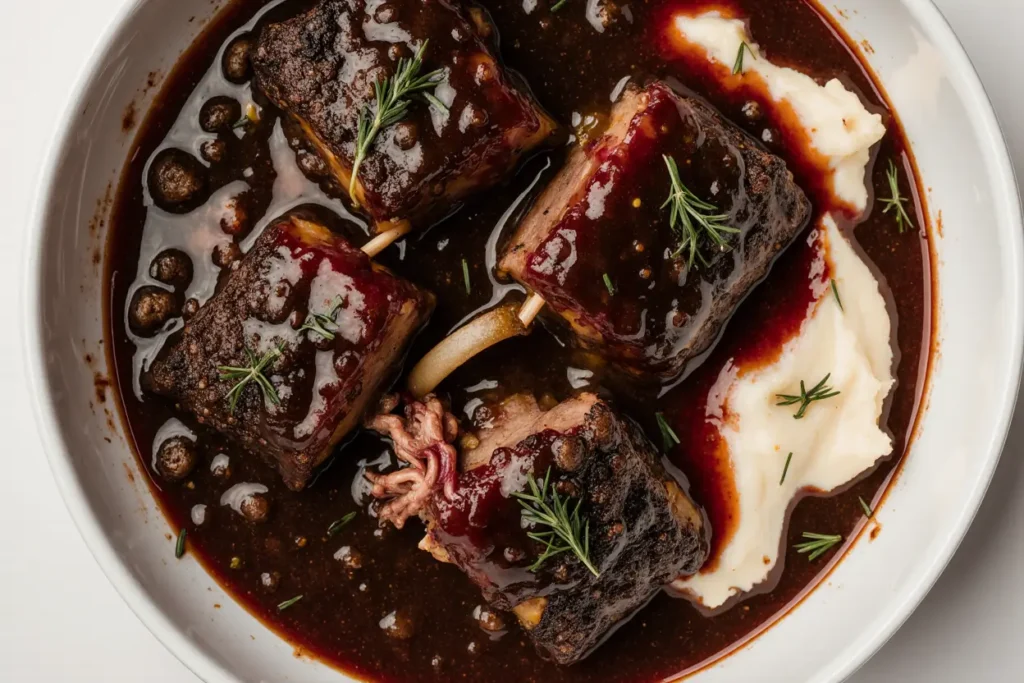
Per serving (serves 6):
- Calories: 485
- Protein: 35g
- Carbohydrates: 8g
- Fat: 28g
- Fiber: 2g
- Sodium: 650mg
- Iron: 4.2mg
This dish provides excellent protein content and significant amounts of iron, zinc, and B vitamins. The slow braising process breaks down tough connective tissues into gelatin, which provides joint-supporting nutrients and creates the signature silky texture.
Healthier Alternatives for the Recipe
Reduce Fat: Trim visible fat from ribs before searing and chill the finished sauce to easily remove solidified fat, reducing calories by approximately 25%.
Lower Sodium: Use low-sodium beef broth and reduce added salt, compensating with additional herbs and spices for flavor complexity.
Increase Vegetables: Add root vegetables like parsnips, turnips, or sweet potatoes during the last hour of braising for added fiber and nutrients.
Alcohol-Free Version: Replace wine with additional beef broth plus 2 tablespoons each of balsamic vinegar and tomato paste for depth without alcohol.
Portion Control: Serve smaller portions (4-5 oz) alongside large portions of vegetables and whole grains to maintain satisfaction while reducing calories.
Serving Suggestions
These luxurious short ribs pair beautifully with creamy mashed potatoes, polenta, or buttery egg noodles that can absorb the rich, wine-infused sauce. The robust flavors also complement roasted root vegetables, sautéed greens, or classic comfort sides like Yorkshire pudding.
For wine pairings, serve with the same style of red wine used in cooking, such as Cabernet Sauvignon or Merlot. The complementary flavors enhance both the food and wine experience. A crusty artisan bread is perfect for soaking up every drop of the precious sauce.
Consider serving family-style in the braising pot for rustic charm, or plate individually for elegant dinner parties. The rich, glossy sauce and tender meat create a restaurant-quality presentation that impresses guests while delivering ultimate comfort.
Common Mistakes to Avoid
Skipping the Searing Step: Proper searing creates the foundation of flavor through the Maillard reaction. Rushing this step results in bland, one-dimensional taste.
Using Too High Heat: Braising should be a gentle simmer, not a rolling boil. High heat toughens the meat and can cause the sauce to break or become greasy.
Not Enough Liquid: The braising liquid should cover at least 2/3 of the meat. Too little liquid can cause burning and uneven cooking.
Overcrowding the Pot: Sear in batches if necessary. Overcrowding prevents proper browning and creates steam instead of the desired caramelization.
Using Poor Quality Wine: Never cook with wine you wouldn’t drink. Poor quality wine will negatively impact the entire dish’s flavor profile.
Storing Tips for the Recipe
Refrigerator Storage: Store cooled short ribs in their braising liquid in the refrigerator for up to 4 days. The flavors actually improve over time as they continue to meld.
Freezer Storage: These ribs freeze beautifully for up to 3 months. Freeze in the braising liquid in airtight containers, leaving space for expansion.
Reheating Instructions: Reheat gently in a 325°F oven or on the stovetop over low heat, adding a splash of broth if needed. Avoid microwaving, which can make the meat tough.
Make-Ahead Tips: This dish can be made 1-2 days ahead and actually improves in flavor. Cool completely before refrigerating, then reheat gently before serving.
Conclusion
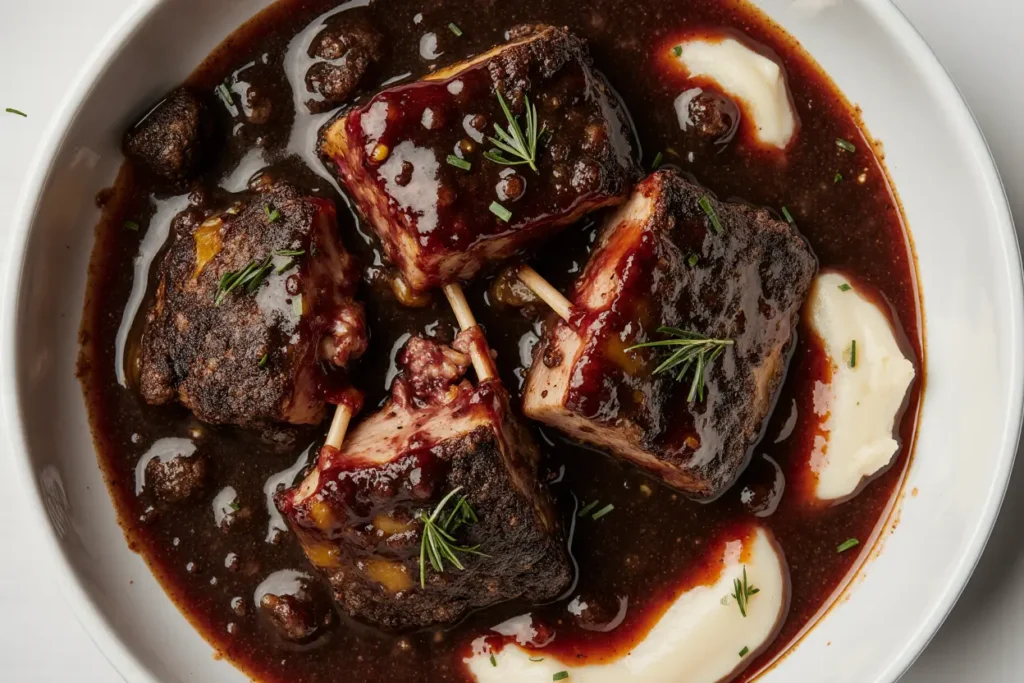
Red wine braised short ribs represent the ultimate expression of comfort food mastery, transforming humble ingredients into an extraordinary dining experience through patience, technique, and quality ingredients. This dish embodies the essence of slow cooking, where time and gentle heat work together to create fall-off-the-bone tenderness and complex, wine-enriched flavors that satisfy both body and soul. The rich, velvety sauce and succulent meat create a meal that’s both comforting and sophisticated enough for special occasions.
Ready to create your own masterpiece of comfort food? This recipe rewards patience with incredible results that will become a treasured family favorite. The intoxicating aroma of wine-braised beef will fill your home with warmth and anticipation, while the final result delivers satisfaction that only true comfort food can provide. Start your slow-braised journey today and discover why this classic technique has been bringing families together around the dinner table for generations!
FAQs
Q: Can I make this recipe without wine? A: Yes, substitute the wine with additional beef broth plus 2 tablespoons each of balsamic vinegar and tomato paste. The flavor will be different but still delicious.
Q: What’s the best cut of short ribs to use? A: Look for well-marbled, bone-in short ribs cut flanken-style or English-cut. The bone adds flavor and the marbling ensures tenderness. Avoid lean cuts that won’t break down properly.
Q: How do I know when the short ribs are done? A: The meat should easily pull away from the bone and a fork should slide in with no resistance. Internal temperature should reach 195°F (90°C) for optimal tenderness.
Q: Can I use a slow cooker instead of the oven? A: Yes, after searing and building the sauce, transfer everything to a slow cooker and cook on low for 6-8 hours. The texture will be slightly different but still delicious.
Q: Why is my sauce not thickening? A: Reduce the strained braising liquid by simmering until it coats a spoon. You can also whisk in a slurry of cornstarch and cold water if additional thickening is needed.
Q: What wine works best for braising? A: Use a dry red wine you’d enjoy drinking, such as Cabernet Sauvignon, Merlot, or Côtes du Rhône. Avoid cooking wines with added salt, which can make the dish overly salty.

